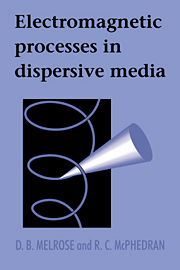Book contents
- Frontmatter
- Contents
- Preface
- List of Symbols
- Part One Electromagnetic Fields in Vacuo
- Part Two Electromagnetic Responses of Media
- Chapter 6 The Response of a Medium
- Chapter 7 General Properties of Response Tensors
- Chapter 8 Analytic Properties of Response Functions
- Chapter 9 Response Tensors for Some Idealized Media
- Chapter 10 Response Tensors for Plasmas
- Part Three Wave Properties
- Part Four Theory of Emission Processes
- Part Five Specific Emission Processes
- Bibliographic Notes
- Index
Chapter 9 - Response Tensors for Some Idealized Media
Published online by Cambridge University Press: 27 October 2009
- Frontmatter
- Contents
- Preface
- List of Symbols
- Part One Electromagnetic Fields in Vacuo
- Part Two Electromagnetic Responses of Media
- Chapter 6 The Response of a Medium
- Chapter 7 General Properties of Response Tensors
- Chapter 8 Analytic Properties of Response Functions
- Chapter 9 Response Tensors for Some Idealized Media
- Chapter 10 Response Tensors for Plasmas
- Part Three Wave Properties
- Part Four Theory of Emission Processes
- Part Five Specific Emission Processes
- Bibliographic Notes
- Index
Summary
Preamble
The response tensor for a dielectric depends on the polarizability of the individual atoms and molecules. In a “dense” isotropic medium, where “dense” is not a well-defined concept, the relation between the dielectric constant and the polarizability is given by the Lorenz–Lorentz relation. The polarizability needs to be calculated quantum mechanically, but many of the features of the response of a dielectric may be inferred from a classical model of forced oscillators.
The Polarizability of Atoms and Molecules
A simple model for the response of dielectric materials is based on assuming that the response results from induced electric dipole moments in the medium. One distinguishes between three classes of polarization on a microscopic level in different types of media. One class consists of media in which the polarization is attributed to deformation of atoms or molecules so that the mean centers of the positive and negative charges become slightly separated, implying that the atoms or molecules develop induced dipole moments. A second class of media consists of those in which the individual particles have intrinsic dipole moments. These moments are randomly oriented in the absence of an external field and become partially aligned in the presence of an external field. The responses for these two classes of media exist for static fields as well as for oscillating fields. The third class of media consists of charges that are free to move and such media become polarized in the sense that there is a net displacement between the positive and negative charges.
- Type
- Chapter
- Information
- Electromagnetic Processes in Dispersive Media , pp. 102 - 114Publisher: Cambridge University PressPrint publication year: 1991



